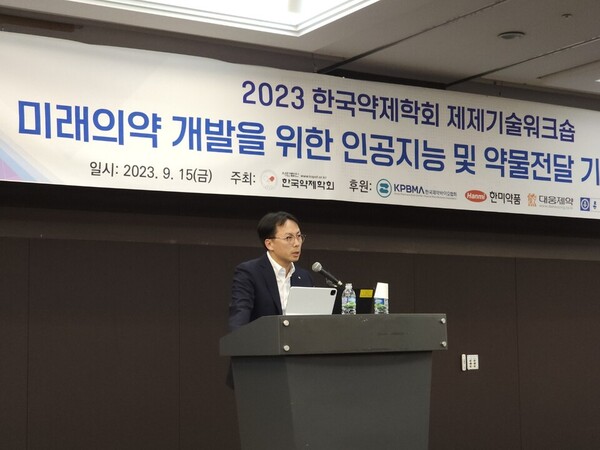
As Korean and foreign pharmaceutical and biotechnology companies are stepping up to develop antibody-drug conjugates (ADCs), Daiichi Sankyo presented its outlook on the future direction of ADC development.
Daiichi Sankyo co-developed Enhertu (trastuzumab deruxtecan), a new generation ADC anticancer drug, with AstraZeneca.
At a workshop organized by the Korean Society of Pharmaceutical Science and Technology last Friday, Daiichi Sankyo Korea CEO Kim Jeong-tae gave a presentation, "Paradigm Shift in Anticancer Treatment: The Case of Antibody Drug Conjugate Enhertu" to introduce the clinical research of Enhertu and the future direction of ADC development.
CEO Kim introduced the major clinical results of Enhertu, explaining the mechanism of how Enhertu showed high efficacy compared to standard treatment. Enhertu is an ADC jointly developed by Daiichi Sankyo and AstraZeneca and was approved by the U.S. FDA in 2019. It has four approved indications.
In Korea, it is approved for two indications: treatment of locally advanced or metastatic HER2-positive adenocarcinoma of the stomach or gastroesophageal junction that have received two or more prior therapies, including anti-HER2 therapy and treatment of patients with unresectable or metastatic HER2-positive breast cancer who have received one or more prior anti-HER2-based therapies.
According to Kim, Enhertu has a structure that combines an anti-HER2 humanized IgG1 monoclonal antibody with the same amino acid sequence as trastuzumab and a payload (drug) deruxtecan with cytotoxic activity, connected by a tetrapeptide-based linker (GGFG). It has a mechanism to concentrate cytotoxic antitumor drugs to cancer lesions, minimize damage to normal tissues, and maximize anticancer effects.
While conventional ADCs have a drug-antibody ratio (DAR) of 2 to 4, Enhertu maintains a relatively high DAR of 8. The GGFG tera peptide-based linker reduces the hydrophobicity of the ADC, allowing it to remain stable in plasma, Kim explained. In particular, it can induce the death of neighboring tumor cells through a "bystander effect," he added.
"Nobel Prize winner in Physiology or Medicine Paul Erlich first proposed the concept of 'magic bullet' in 1913, and it was not until the 2000s that it was implemented as the first ADC 'Mylotag,' and 12 ADCs have been developed to date," Kim explained. “Many companies are using the name 'magic bullet,' but the drug that best fits the concept is Enhertu.”
Explaining the significance of the DESTINY-Breast04 study, a phase 3 clinical trial of Enhertu, Kim said, "While the existing treatments for metastatic breast cancer were divided into HER2-positive or negative, Enhertu created a new biomarker called 'HER2 low expression,' making it possible for previously untreated patients to receive treatment."
The DESTINY-PanTumor02 study was designed to determine if Enhertu could be effective in other cancers, as it was highly effective in lung, stomach, breast, and colorectal cancers in previous studies, Kim noted. Researchers studied cervical, endometrial, ovarian, biliary, pancreatic, and bladder cancers and found a high objective response rate (ORR) and long duration of response (mDOR), he added.
"This suggests that Enhertu is effective regardless of the cancer type, and we expect approval shortly as ENHERTU has been granted Breakthrough Therapy designation for pan-tumor," Kim said.
In addition, Kim compared first-generation and second-generation ADCs, saying, "First-generation ADCs are lysine conjugated, such as Kadcyla (trastuzumab emtansine). The second generation is cysteine conjugated, represented by Enhertu. The disadvantage of lysine conjugation is that the conjugation is not uniform, and cysteine conjugation solves this problem."
Looking ahead to the future of ADCs, ADCs have only been able to capture one specific antigen because they use a single antibody. Therefore, ADCs utilizing double antibodies are being developed, Kim said. Besides, ADCs utilizing multiple payloads instead of one payload are also being developed to overcome the problem of resistance to cytotoxic chemical payloads, he added.
"Furthermore, research is underway to conjugate payloads that activate immune cells in the body, such as TLR8 agonists and Sting agonists, rather than cytotoxic chemicals that can damage normal cells. Combination therapy with immuno-oncology and targeted anticancer drugs is also active,” he added.
In conclusion, Kim said, "Daiichi Sankyo is developing six ADCs. This year, clinical study results of Dato-DXd (datopotamab deruxtecan) and HER3-DXd (patritumab deruxtecan) will be announced."
He added that the company is actively working on the next-generation ADC beyond Dxd-based ADCs, showing the company's commitment to developing follow-on drugs through ADC platform technology.

